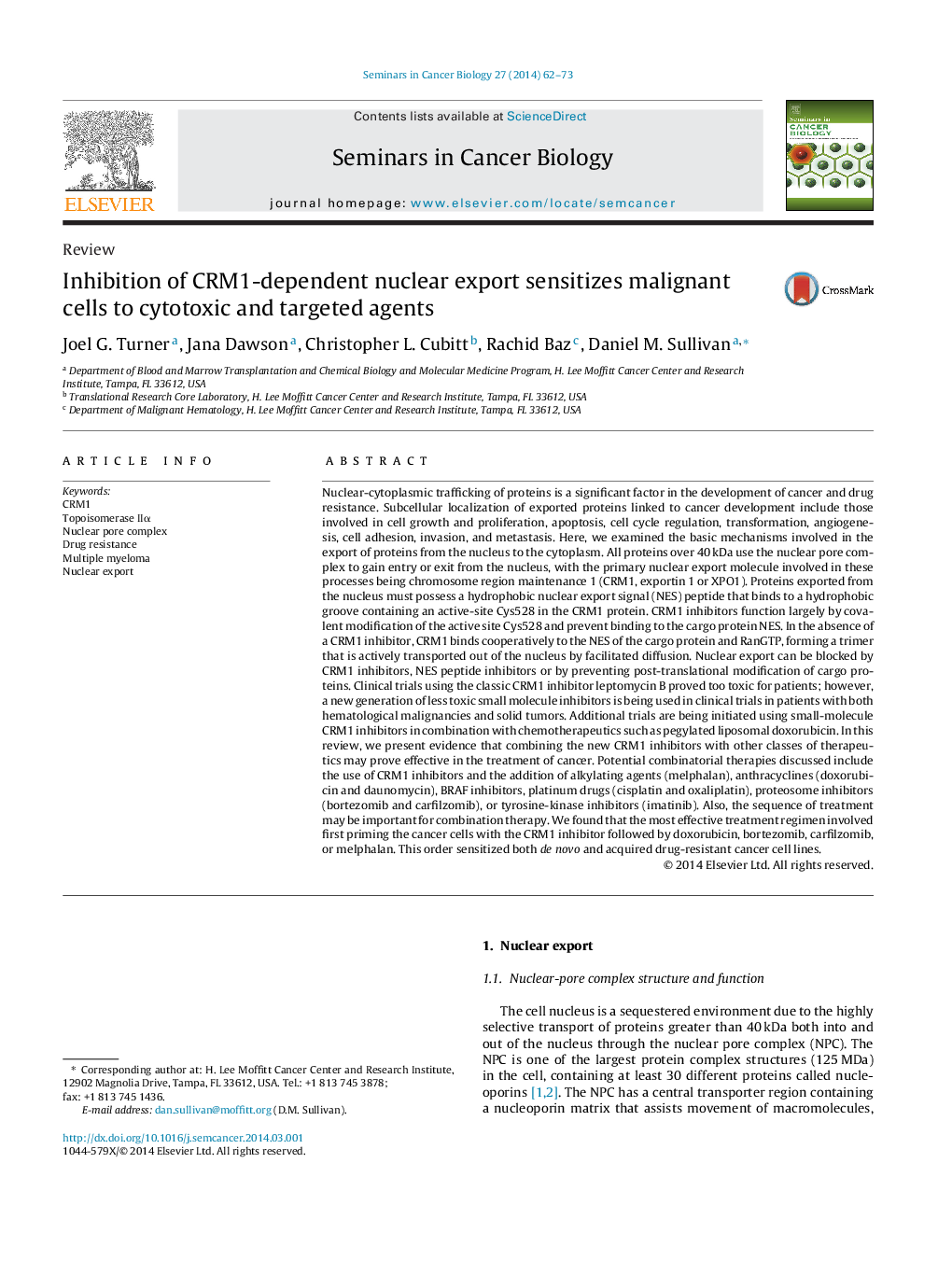| کد مقاله | کد نشریه | سال انتشار | مقاله انگلیسی | نسخه تمام متن |
|---|---|---|---|---|
| 2023694 | 1542540 | 2014 | 12 صفحه PDF | دانلود رایگان |
عنوان انگلیسی مقاله ISI
Inhibition of CRM1-dependent nuclear export sensitizes malignant cells to cytotoxic and targeted agents
دانلود مقاله + سفارش ترجمه
دانلود مقاله ISI انگلیسی
رایگان برای ایرانیان
کلمات کلیدی
موضوعات مرتبط
علوم زیستی و بیوفناوری
بیوشیمی، ژنتیک و زیست شناسی مولکولی
زیست شیمی
پیش نمایش صفحه اول مقاله

چکیده انگلیسی
Nuclear-cytoplasmic trafficking of proteins is a significant factor in the development of cancer and drug resistance. Subcellular localization of exported proteins linked to cancer development include those involved in cell growth and proliferation, apoptosis, cell cycle regulation, transformation, angiogenesis, cell adhesion, invasion, and metastasis. Here, we examined the basic mechanisms involved in the export of proteins from the nucleus to the cytoplasm. All proteins over 40Â kDa use the nuclear pore complex to gain entry or exit from the nucleus, with the primary nuclear export molecule involved in these processes being chromosome region maintenance 1 (CRM1, exportin 1 or XPO1). Proteins exported from the nucleus must possess a hydrophobic nuclear export signal (NES) peptide that binds to a hydrophobic groove containing an active-site Cys528 in the CRM1 protein. CRM1 inhibitors function largely by covalent modification of the active site Cys528 and prevent binding to the cargo protein NES. In the absence of a CRM1 inhibitor, CRM1 binds cooperatively to the NES of the cargo protein and RanGTP, forming a trimer that is actively transported out of the nucleus by facilitated diffusion. Nuclear export can be blocked by CRM1 inhibitors, NES peptide inhibitors or by preventing post-translational modification of cargo proteins. Clinical trials using the classic CRM1 inhibitor leptomycin B proved too toxic for patients; however, a new generation of less toxic small molecule inhibitors is being used in clinical trials in patients with both hematological malignancies and solid tumors. Additional trials are being initiated using small-molecule CRM1 inhibitors in combination with chemotherapeutics such as pegylated liposomal doxorubicin. In this review, we present evidence that combining the new CRM1 inhibitors with other classes of therapeutics may prove effective in the treatment of cancer. Potential combinatorial therapies discussed include the use of CRM1 inhibitors and the addition of alkylating agents (melphalan), anthracyclines (doxorubicin and daunomycin), BRAF inhibitors, platinum drugs (cisplatin and oxaliplatin), proteosome inhibitors (bortezomib and carfilzomib), or tyrosine-kinase inhibitors (imatinib). Also, the sequence of treatment may be important for combination therapy. We found that the most effective treatment regimen involved first priming the cancer cells with the CRM1 inhibitor followed by doxorubicin, bortezomib, carfilzomib, or melphalan. This order sensitized both de novo and acquired drug-resistant cancer cell lines.
ناشر
Database: Elsevier - ScienceDirect (ساینس دایرکت)
Journal: Seminars in Cancer Biology - Volume 27, August 2014, Pages 62-73
Journal: Seminars in Cancer Biology - Volume 27, August 2014, Pages 62-73
نویسندگان
Joel G. Turner, Jana Dawson, Christopher L. Cubitt, Rachid Baz, Daniel M. Sullivan,